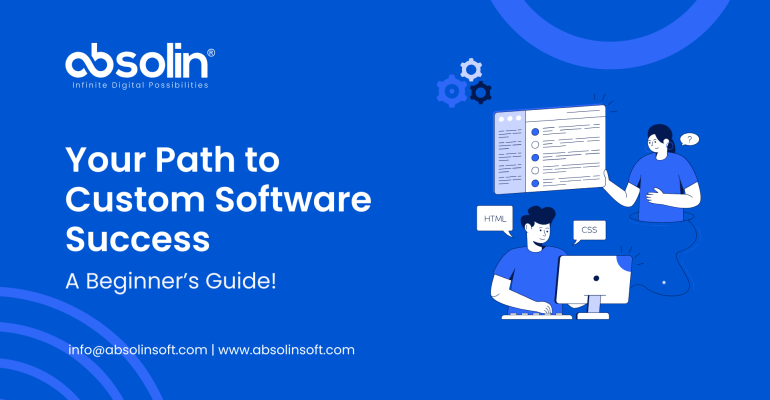A Beginner’s Guide to Custom Software Development
Custom software development is the process of designing, creating, deploying, and maintaining software tailored to meet the specific needs of an organization or user. Unlike off-the-shelf software, custom software is built from the ground up to address unique business requirements, offering greater flexibility, scalability, and alignment with your business goals. If you’re new to custom software development, this guide will help you understand the basics and key considerations to get started.
1. What is Custom Software Development?
Custom software development involves the creation of software solutions that are uniquely tailored to a specific user or organization’s needs. This process typically includes:
- Requirement Analysis: Understanding the specific needs and goals of the business.
- Design: Creating a blueprint of the software, including UI/UX design and architecture.
- Development: Writing the code to bring the software to life.
- Testing: Ensuring the software is bug-free and performs as expected.
- Deployment: Launching the software for use by the intended audience.
- Maintenance and Support: Ongoing updates, bug fixes, and improvements.
2. Why Choose Custom Software Over Off-the-Shelf Solutions?
Custom software development offers several advantages over pre-built, off-the-shelf solutions:
- Tailored to Your Needs: Custom software is designed specifically for your business processes, ensuring a perfect fit.
- Scalability: As your business grows, custom software can be easily scaled to accommodate new requirements.
- Competitive Advantage: Custom solutions can provide unique features that give your business a competitive edge.
- Integration: Custom software can be seamlessly integrated with your existing systems, improving overall efficiency.
- Support and Maintenance: With custom software, you have direct access to support and can ensure that updates and maintenance are aligned with your needs.
3. Key Stages of Custom Software Development
Understanding the key stages of custom software development will help you navigate the process more effectively:
a) Requirement Gathering and Analysis
This initial phase involves working closely with stakeholders to gather detailed requirements. This stage is critical as it sets the foundation for the entire project. Key activities include:
- Workshops and Interviews: Engaging with users and stakeholders to understand their needs.
- Documentation: Creating detailed specifications that outline the software’s functionality.
b) Design
Once the requirements are clear, the design phase begins. This phase includes:
- System Architecture Design: Defining the software’s structure and components.
- User Interface (UI) Design: Creating mockups and prototypes to visualize the user experience.
- Database Design: Designing the database schema that will store the application’s data.
c) Development
In this phase, developers write the code to build the software. Key considerations include:
- Programming Languages: Choosing the appropriate languages and frameworks (e.g., Python, JavaScript, .NET) based on the project requirements.
- Version Control: Using version control systems (e.g., Git) to manage changes to the codebase.
- Agile Development: Often, custom software projects use Agile methodologies, allowing for iterative development and continuous feedback.
d) Testing
Testing is essential to ensure the software functions as intended and is free of bugs. Types of testing include:
- Unit Testing: Testing individual components or modules.
- Integration Testing: Ensuring that different modules work together seamlessly.
- User Acceptance Testing (UAT): Involving end-users to validate the software meets their needs.
- Performance Testing: Evaluating the software’s performance under various conditions.
e) Deployment
Once the software passes all testing phases, it’s ready for deployment. This stage involves:
- Server Setup: Configuring servers for hosting the application.
- Data Migration: Transferring existing data to the new system, if necessary.
- Go-Live: Making the software available for use by the intended audience.
f) Maintenance and Support
Post-deployment, ongoing maintenance is crucial to ensure the software continues to meet the needs of the business:
- Bug Fixes: Addressing any issues that arise after deployment.
- Updates: Implementing new features or changes based on user feedback.
- Performance Monitoring: Continuously monitoring the software to ensure optimal performance.
4. Choosing the Right Development Partner
Selecting the right software development partner is crucial to the success of your custom software project. Consider the following when choosing a partner:
- Experience: Look for a development team with experience in your industry and with similar projects.
- Portfolio: Review their previous work to assess their capabilities.
- Communication: Ensure they have a clear communication process in place to keep you informed throughout the project.
- Support: Verify that they offer ongoing support and maintenance services.
5. Common Challenges in Custom Software Development
Custom software development can be complex, and it’s important to be aware of potential challenges:
- Scope Creep: This occurs when additional features are added after the project has started, leading to delays and increased costs. Clear documentation and change management processes can help mitigate this risk.
- Budget Overruns: Custom software development can be expensive, especially if not well-planned. It’s important to have a clear budget and timeline from the start.
- Integration Issues: Integrating the new software with existing systems can be challenging. Ensure that integration is considered early in the design phase.
Conclusion
Custom software development offers businesses the flexibility and scalability needed to stay competitive in today’s digital world. By understanding the key stages of development, choosing the right partner, and being aware of potential challenges, you can successfully navigate the process and create a software solution that drives your business forward. Whether you’re looking to automate processes, improve customer experiences, or gain a competitive edge, custom software development is a valuable investment in your business’s future.



